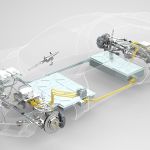At the 2021 Mackinac Policy Conference in Mackinac Island, MI, General Motors President Mark Reuss revealed the company’s group of three new motors that will power its Ultium-based EVs. All three motors were engineered and calibrated in-house to ensure the highest level of performance in Ultium-based EVs. They were built as a scalable family, sharing design principles as well as similar tooling and manufacturing strategies.
“Twenty years of electric-drive-system development and more than 100 years of high-volume vehicle engineering are helping GM pivot quickly from conventional vehicles to EVs,” said Reuss. “Our vertical integration in this space, encompassing both hardware and software, helps give us control over our own destiny and a significant competitive advantage.”
Three Ultium Drive motors
The GM-engineered Ultium Drive motors are a 180-kW front-drive motor, 255-kW rear- and front-drive motor, and 62-kW all-wheel-drive assist motor. The 180- and 255-kW units are permanent magnet motors designed with the aim of minimizing reliance on rare-earth materials, while the 62-kW unit is an induction motor. All are expected to offer class-leading torque and power density, enabling applications in a range of vehicle types from performance cars to work trucks.
GM’s new EV motor family and integrated power electronics, contained within its Ultium Drive units, will debut on the 2022 GMC Hummer EV later this year. As many as three electric motors can be used in one EV. Variations of the GMC Hummer EV will feature three 255-kW motors, yielding a GM-estimated output of 1000 hp (748 kW) on select trims such as Edition 1 and EV3x.
GM engineers developing the software for Ultium Drive’s motor controllers was key in serving the propulsion needs of various vehicle types with a minimal set of components, believes the company. GM also designed the software of key power electronics components like the power inverter module, which converts the battery pack’s DC voltage to the motors’ AC voltage.
The Ultium Drive engineers, based at GM’s Global Technical Center in Warren, MI; Global Propulsion Systems in Pontiac, MI; and Milford Proving Ground are part of the nearly 11,000 GM product development team members currently working in software development. This number is projected to grow, with software serving as a critical pillar of the company’s vision of an all-electric future, according to GM.
Computer-assisted and virtual engineering are said to have enabled the development team to move quickly, safely, and cost-effectively—while also improving vehicle controls. Artificial intelligence and machine learning helped determine the most efficient ways to distribute torque in three-motor systems, like in the GMC Hummer EV.
That vehicle’s 0-60 mph (0-97 km/h) acceleration in a GM-estimated 3 s in “Watts to Freedom” mode is largely due to GM’s electric drive software expertise in addition to its key competencies in motor controls, power electronics, motor design, and development.
The software behind GM’s EV motors can be reused in many applications, providing fast go-to-market times as well as the foundation for future EV expansion, as the motors are versatile enough to provide the power needs for a complete lineup of vehicles.
The inverter and other power electronics, like the accessory power module and onboard charging module, reside outside of the drive units on GM’s current EVs. In Ultium-based vehicles, they will be integrated directly into Ultium Drive units, reducing cost and manufacturing complexity.
Five Ultium Drive units
The three motors will power five interchangeable drive units, helping the company transition its current portfolio to a fully electric lineup. The Ultium Drive units combine electric motors and single-speed transmissions to apply power generated by Ultium battery cells to the wheels of GM’s upcoming electric vehicles.
“GM has built transmissions for many notable automakers,” said Ken Morris, GM Vice President, Autonomous and Electric Vehicle Programs. “Making motors, transmissions, driveline components, and systems are among GM’s best-known competencies, and our manufacturing expertise is proving not only transferable but advantageous as we make the transition to EVs.”
GM applied 25 years of EV experience to Ultium Drive with lighter and more efficient designs that feature clever integrations. For example, by integrating the power electronics into the drive units’ assemblies, the mass of the power electronics has been reduced by nearly 50% from GM’s previous EV generation, saving cost and packaging space while increasing capability by 25%.
The company says this consolidation of parts and features in combination with its industry-first almost completely wireless battery management system makes it easier to scale Ultium Drive across GM’s future EV lineup. It will also help GM migrate high-output segments like pickup trucks and performance vehicles to all-electric propulsion. The Ultium Drive family covers front-, rear-, and all-wheel-drive propulsion combinations including high-performance and off-road capabilities.
Most of the Ultium Drive components will be built with globally sourced parts at GM’s existing global propulsion facilities on shared, flexible assembly lines—allowing the company to ramp up its EV production more quickly, achieve economies of scale, and adjust its production mix to match market demand.
- 2022 GMC Hummer EV pickup.
- 2022 GMC Hummer EV pickup.
- 2022 GMC Hummer EV Ultium platform.
- GM Ultium Drive (stator) family.
- GM Ultium Drive 255-kW EV motor.
- GM Ultium Drive 180-kW EV motor.
- GM Ultium Drive 62-kW EV motor.
- GM Ultium Drive power electronics.







































































































